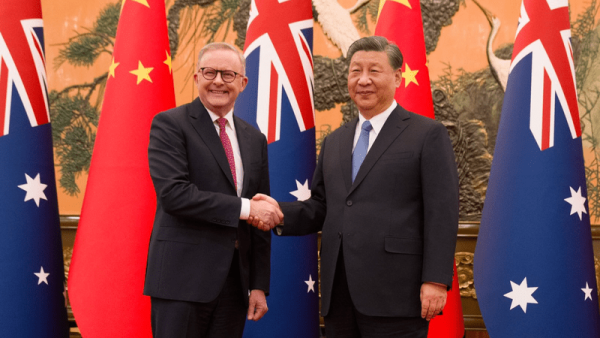@AlboMP / X

Elena Collinson, Manager, Research Analysis, Australia-China Relations Institute, University of Technology Sydney |
This article appeared in The Australian Financial Review on November 6 2023.
It is striking that before Anthony Albanese headed into his crucial meetings with the senior Chinese leadership in Beijing, neither the prime minister nor Foreign Minister Penny Wong mentioned the South China Sea.
While Albanese mentioned ‘strategic competition’, he was loath to be drawn on the specifics of his forthcoming discussions.
But he was asked about whether he could trust President Xi Jinping. And it is China’s broken trust on the South China Sea that continues to haunt Beijing’s relations with Washington and much of South-East Asia.
The reality is that the South China Sea remains the very fulcrum of the China problem for the United States and its allies and partners, including Australia. It gives credence to the observation of top US Asia policy hands Kurt Campbell and Ely Ratner in 2018 that Washington has been unable to ‘mould China to the United States’ liking’.
Much of this story began eight years ago in a supposed guarantee that China’s President Xi Jinping gave his then US counterpart Barack Obama in the White House’s Rose Garden. Even as terraforming efforts were under way, Xi told the world that China ‘does not intend to pursue militarisation’ of the South China Sea.
This turned out to be an empty promise.
In the years since, Beijing has turned rocky outcrops into potential launch pads of intimidation, installing missile systems and deploying fighter jets.
It has categorically rejected the 2016 Hague arbitral tribunal ruling that found against its territorial claims, this year releasing a new ‘standard map’ redrawing territorial maritime boundaries.
The Americans and much of the region, including Australia, now know for certain they are dealing with a very different Chinese leader – the most forward-leaning on foreign policy since Mao Zedong.
To be sure, Beijing has pivoted in the way it is choosing to deal with the world, softening its foreign policy approach and deploying a more active diplomacy. Xi has said he wants China to be loved again.
It has more enthusiastically pushed for a rapprochement with Australia and renewed dialogue with the US. Beijing has also attempted to play the role of peacemaker between Ukraine and Russia, and helped broker the improvement of ties between Saudi Arabia and Iran.
Charm offensive has its limits
But as it treads more softly in other arenas, there is a new edge to Beijing’s aggressive pursuit of its territorial claims in the waterway, manifest most recently in a series of confrontations with Philippine vessels and a near miss with a US fighter jet.
Clearly, then, China’s charm offensive has its limits. Beijing remains intensely protective of what it sees to be its sphere of influence.
So it was significant that Albanese stood side by side with Philippines President Ferdinand Marcos jnr before heading to Washington last month. This would have been appreciated in the US capital.
And when standing alongside Joe Biden, Albanese could not have missed the US president’s message of strong reassurance to Manila about its defence guarantee in the light of another round of Chinese maritime bullying.
For the US, this too presents a conundrum for its ideal of global leadership. Elsewhere in the world, it has retained the ability to make its presence felt – continuing to marshal Western efforts in aiding Ukraine, dispatching significant firepower in the form of two aircraft carrier strike groups to the Mediterranean and off the Persian Gulf as conflict rages in Gaza, facilitating closer military enmeshment with Australia, and strengthening its web of Asian allies more generally.
But in the South China Sea, Washington and its allies have been unable to halt Beijing’s steady encroachment. What Xi has presided over in the region is something that Albanese and Biden do not seem to think they can fundamentally change. There seems to be nary a whisper about conducting freedom-of-navigation operations within 12 nautical miles of disputed features.
Facts on the water
These are the facts on the water that China has unilaterally established. This is where Albanese’s rhetoric of ‘stability’ meets a difficult reality. Australia cannot change what has already taken place, it can only hope for ‘stabilisation’.
But is this realistic? The prime minister says he wants a ‘no surprises’ relationship in the future, so he knows ‘where things are coming from’. However, there is unlikely to be a relationship that involves Beijing consulting Canberra before making its next move in this vital waterway for the world’s trade.
There is a further problem in the relative quiet of Canberra’s recent statements on the South China Sea. Though this has not explicitly been spelt out, the very essence of the AUKUS agreement and much of the capability foreseen by the Defence Strategic Review is to give expression to what Defence Minister Richard Marles calls ‘impactful projection’ – the ability to ‘hold an adversary at risk’ much further from Australian shores.
Nuclear-powered submarines will be able to more easily carry out missions closer to the Chinese coast. Beijing’s response to AUKUS so far has been relatively muted; it is no doubt conscious that the delivery of that Australian capability is a long way off.
Author
Elena Collinson is head of analysis at the Australia-China Relations Institute, University of Technology Sydney.


